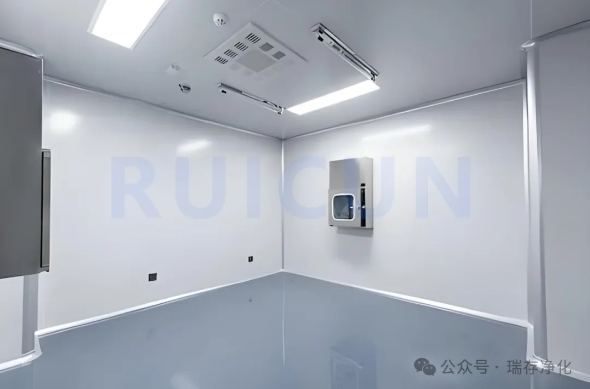News Center
Unidirectional flow for cleanroom air flow analysis
2025/1/20
In clean technology, since the United States FS209C divided the air flow in the clean room into unidirectional flow and non-unidirectional flow, this term has been widely adopted.

From the perspective of fluid mechanics, the flow state of fluid is described. According to whether the velocity of mass point changes with time, it can be divided into stable flow and unsteady flow.
According to whether the flow rate changes with the flow direction, it is divided into uniform flow and non-uniform flow. Heterogeneous flow can be divided into gradual flow and rapid flow.
The stable operation of the air conditioning system is generally a constant flow. The air flow in the clean room is non-uniform flow except for the typical uniform flow of the ceiling, the air supply of the high efficiency filter and the return air of the floor grid.
In stable flow, it can be divided into laminar flow and turbulent flow according to Re number.
In the clean room, due to the large fault area, it does not belong to laminar flow either in stable flow. Laminar flow is only possible in clean pipes.
The flow classification of clean rooms (the following are all based on the United States FS209 as an example) was initially divided into laminar flow and turbulence.
Us FS209C began to change laminar flow to unidirectional flow, turbulence to non-unidirectional flow. The name is obviously more apt. FS209C (issued October 27, 1987) : "Air flow through a clean room or clean area in a single channel in a parallel direction"; FS209D (issued on June 15, 1989) : "Generally with parallel flow lines, in a single path, a single direction through the clean room or clean area air flow"; FS209E (issued September 11, 1992) : "Air currents that generally have parallel currents, flow in a single direction, and have consistent wind speeds across a cross-section." To sum up, there are three conditions for the formation of unidirectional flow in the clean room, that is, the three elements of unidirectional flow: airflow speed, flow line non-uniformity, and airflow parallelism. However, there is no quantitative numerical limit on the three factors.
FS209E has been abolished, but the international standard ISO14644 and China's "clean workshop design Code" GB50073, the description of one-way flow, still use FS209E.
Analysis of three elements of one-way flow
1. Airflow speed
The airflow speed should be selected so that the entire airflow flows evenly without a holdup zone. The airflow velocity in the non-retention zone must be greater than 0.08m/s.
General clean room height H=2.5 ~ 3.5m when υ≥0.08m/s, n≈100 times /, which is the minimum number of air changes that must be met when clean unidirectional flow state appears.
The airflow speed should be able to resist the interference of personnel activities and thermal floating, and also resist the influence of free settling of dust particles in the horizontal unidirectional flow. When the personnel are active, it is equivalent to an external force acting on the dust particles. When an object is acted upon by an external force, it produces an initial velocity at which the object moves. When the external force disappears, the object will get the instantaneous speed, the mechanical force (personnel activities) basically does not affect the transfer of dust particles, after the external force disappears, dust particles will continue to flow along the streamline.
Whether the particles can move with the air flow depends on the size of the suspension speed of the dust particles. The suspension speed of dust particles is very small, as long as there is a weak airflow can take it away.
The average adult's heat output is 0.1Kw, and an updraft of 0.2m/s can be generated above the human head in still air. So the wind speed of the vertical unidirectional flow has to overcome the speed of this heat float.
In summary, for vertical unidirectional flow, the airflow velocity υ≥0.25m/s can meet the requirements. In horizontal unidirectional flow, in addition to moving with the air flow, the dust particles are also subjected to a gravitational action, but the distance of particle settlement is very small, and will not be too far away from the original flow line. From above, the airflow velocity of both vertical and horizontal unidirectional flow υ≥0.25m/s is sufficient. Horizontal unidirectional flow can increase the flow rate a little.
The above analysis is calculated by isothermal air supply, if there is a strong heat source in the room, it is a different matter, and other measures need to be taken.
2, the non-uniformity of air flow speed
At the early stage of the development of clean technology, the requirements for the non-uniformity of air flow are very strict. FS209B states that the non-uniformity is within ±20%. This regulation does not specify whether it is the design wind speed or the measured average wind speed at that speed as the reference value. It is generally believed that its approximate value is the average wind speed measured in the section.
After the United States FS209, the requirement of airflow unevenness was deleted. This is clearly an understanding derived from long-term practice.
From the long-term testing of clean rooms, it is found that this requirement is basically not met. We know that except for the core part of the main body segment of the jet, the air velocity is equal and the flow lines are parallel, other parts are impossible. Due to the uneven density of the filter material, the uneven pressure of the filter air supply plenum, and the no-wind zone formed by the adjacent high efficiency filter frame, the wind speed at the air outlet lap of the adjacent filter is different from the air outlet wind speed on the filter surface.
However, the design still needs to consider the influence of the uneven degree of air flow on the cleanliness.
3, the parallelism of the streamline
Various specifications stipulate that one element of unidirectional flow is the parallel flow lines. This has so far been maintained. However, it turns out that complete parallelism is not necessary.
We know that the air velocity is equal and the flow line is parallel, and only two cases can be achieved: (1) The core of the initial segment of the jet. ② Straight pipe section with Welosinski curve entrance. Other scenarios are not possible for a variety of reasons. As long as the flow lines (traces) in the entire air stream do not cross and do not form a vortex region, the dust particles will be discharged along the trace lines (streamlines) and will not be trapped. From the above analysis, it can be seen that as long as the whole air flow in a channel, there is no vortex zone between the flow lines, and the dust particles can be discharged if the flow lines are parallel or uniform. Therefore, it is not necessary for the flow line to be parallel, and because of the non-uniformity of the flow speed, the transverse pressure changes are formed, and the flow line is completely parallel.
So, under what circumstances does the vortex zone not form between the two flow lines? A purely theoretical discussion of this has yet to be seen. In fluid mechanics, there is a semi-empirical formula for the local resistance loss of a gradually expanded tube. When the expansion Angle is 5-80 degrees, the resistance loss is the least, which means that the diffusion Angle is 5-80. In addition to the friction resistance, the loss is only caused by the change of flow velocity distribution caused by the gradual expansion of the fluid flow section, and there is basically no vortex zone loss, and the fluid does not leave the expansion tube wall.
Therefore, it can be considered that as long as the outlet flow, the adjacent flow line Angle is less than 5-80 degrees, the entire air flow will flow along a single overall trend. Because in this case, the dust particles can still flow along their own trace without interference, which achieves the purpose of drainage.






